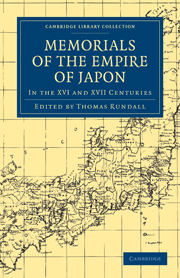THE LETTERS OF WILLIAM ADAMS
Published online by Cambridge University Press: 05 August 2011
Summary
Introduction
The first letter sent by William Adams for England, he thus addresses: “TO MY VNKNOWNE FRINDS AND COUNTRI-MEN: dessiring this letter by your good meanes, or the newes or copie of this letter, may come into the hands of one, or manny of my acquayntance in LIMEHOVSE or else wheare, or in KENT in GILLINGHAM, by ROCHESTER.”
Probably through the agency of their Factors recently settled at Bantam, two copies of the letter were transmitted to the “Worshipfull Felowship of the Merchants of London trading into the East Indies”; and in the sequel it will be perceived the communication led to the opening of commercial intercourse between England and Japon.
Purchas has given a version of this letter (Pilgrims, vol. i, page 125, etc.); but it is to be viewed as a loose paraphrase only. In the variations he has adopted, erroneously or capriciously, the sense is not unfrequently destroyed; and the unaffected earnestness which characterizes the original, is rarely preserved. The version now given is founded on two manuscript copies, preserved among the records of the East India Company. Many of the variations between the printed and manuscript copies are noted; but to exhibit the whole, it would be necessary to print the two versions in juxtaposition, which would occupy more space than seems adviseable.
Hauing so good occasion, by hearing that certaine English marchants lye in the island of Iaua, although by name vnknowen, I haue ymboldened my selfe to wryte these few lines, desiring the Worshipfull Companie being vnknowen to me, to pardon my stowtnes.
- Type
- Chapter
- Information
- Memorials of the Empire of JaponIn the XVI and XVII Centuries, pp. 15 - 88Publisher: Cambridge University PressPrint publication year: 2010First published in: 1850

